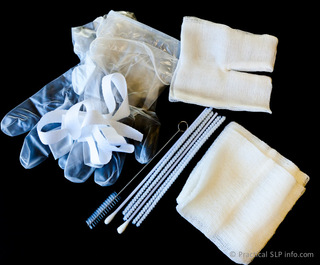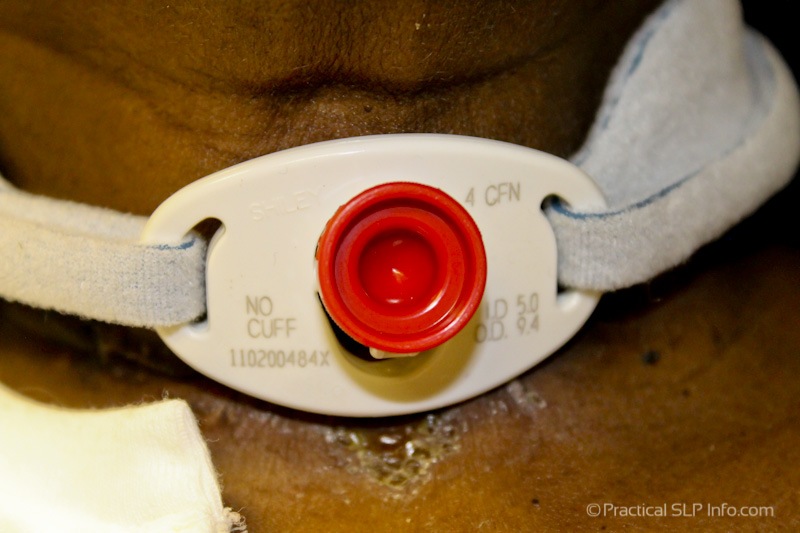Tracheostomy Care
To ensure adequate function of the tracheostomy, and to minimize potential complications from the tracheostomy, proper care and maintenance is important.
Tracheostomy site
Typical wound care instructions will apply during the initial days following a tracheotomy. Application of an antibacterial agent will typically be prescribed by your surgeon to use over the initial post-operative days. There will be a small amount of blood/bloody drainage during these initial days as well, which is normal. Should there be signs of infection, however, you should contact your doctor immediately.
Potential signs of infection
Typical signs of infection would be worsening/intense pain at the wound site after the first 2-3 days. Typically, pain associated with a tracheotomy is not severe and should improve over the first 3-5 days following surgery. If this does not happen, however, it is important to contact your physician for further evaluation.
Any significant swelling/ inflammation, especially an increase after the first four post-operative days, may be an indication of a local infection and should be reported to your doctor. Although it may be difficult and/or uncomfortable to use tracheostomy ties in the presence of significant selling, it is important that the tube be properly secured. Ties that are too loose or left untied can allow the tracheostomy tube to come out entirely. Never leave a tube unsecured.
Any drainage or discharge from the wound should be clear. Thicker or more opaque secretions (like puss) should be reported to your doctor. Also, a foul smell not previously noted may be an indication of infection or other issue and should also be reported.
Any significant swelling/ inflammation, especially an increase after the first four post-operative days, may be an indication of a local infection and should be reported to your doctor. Although it may be difficult and/or uncomfortable to use tracheostomy ties in the presence of significant selling, it is important that the tube be properly secured. Ties that are too loose or left untied can allow the tracheostomy tube to come out entirely. Never leave a tube unsecured.
Any drainage or discharge from the wound should be clear. Thicker or more opaque secretions (like puss) should be reported to your doctor. Also, a foul smell not previously noted may be an indication of infection or other issue and should also be reported.
Cleaning
Prior to discharge from the hospital following your tracheotomy, nursing staff should provide you with care/cleaning instructions. Daily cleaning of your tube is important, which may include cleaning and/or replacing the inner cannula. There are commercially available tracheostomy cleaning kits available which are very helpful in helping with the care of your tracheostomy.
Following the manufacturer’s guidelines for cleaning is important. Always ask your nurse of doctor for proper care instructions as these may vary depending on the tracheostomy tube you have.
Decannulation
Decannulation refers to the removal of the tracheostomy tube once it is no longer required. Your doctor will determine when decannulation is appropriate and this can be conducted very easily in the office.
Before it is determined that you no longer require your tracheostomy tube, your doctor may conduct trials to determine how you tolerate breathing through the nose and mouth again. There trials are usually done via two methods: weaning or capping. Often times, capping will be conducted at the end of a weaning trial to ensure you are ready to return to breathing through your upper respiratory tract.
Weaning
This process can be conducted various ways, although the most common is to begin by using a Passy-Muir Speaking Valve (PMV) if you are not already using one. The PMV requires you to exhale through the nose/mouth while still allowing you to inhale via the tracheostomy tube. In this sense, you breathe only partially through the tube which serves as a good determinant is assessing if you may be ready to be decannulated. Although not always, if you are unable to tolerate the PMV during prolonged use throughout the day, it is unlikely you are ready to be decannulated.
In some cases, weaning from your tracheostomy tube may also include down-sizing; which means your current tracheostomy tube size is exchanged to a smaller size. Essentially, the space you have to breath through your tracheostomy is made smaller, usually requiring more respiration activity through the nose and mouth. Since airflow follows the “path of least resistance,” by making the tube size smaller, air should more easily low through the nose and mouth after down-sizing. Although not always, if you are unable to tolerate down-sizing of your tracheostomy tube, it is unlikely you are able to be decannulated.
Down-sizing may be conducted in combination with PMV utilization and/or capping trials during the weaning process.
In some cases, weaning from your tracheostomy tube may also include down-sizing; which means your current tracheostomy tube size is exchanged to a smaller size. Essentially, the space you have to breath through your tracheostomy is made smaller, usually requiring more respiration activity through the nose and mouth. Since airflow follows the “path of least resistance,” by making the tube size smaller, air should more easily low through the nose and mouth after down-sizing. Although not always, if you are unable to tolerate down-sizing of your tracheostomy tube, it is unlikely you are able to be decannulated.
Down-sizing may be conducted in combination with PMV utilization and/or capping trials during the weaning process.
Capping Trials
Capping trials refers to times when a “cap” is placed over the tracheostomy tube opening to close off airflow via the tube. In doing so, the tube no longer acts as a means of airflow, allowing respiration entirely through the nose and mouth.
Capping trials may be started using a particular schedule, asking you to wear the cap for specified amounts of time. If this is well tolerated, you will be asked to wear the cap 24/7 for a period of a few to several days. If 24/7 capping is well tolerated, this is a good indication the tracheostomy tube is no longer needed and decannulation can be planned.
Although capping trials provide a good sense of how you will tolerate breathing without the tracheostomy tube, it is important to remember that breathing will be easier following decannulation. If the cap is not well tolerated, and no particular upper airway obstruction is noted. It may be that the tube itself is creating too much obstruction to airflow and you may be down-sized as a result. By placing a smaller tube, and replacing a cap, this will allow for improved airflow around the tube and likely, better tolerance for the capping.
Tube Removal and Wound care
Your doctor will establish how best to assess your ability to breath without a tracheostomy. Although once this is determined, the tracheotomy tube itself is easily removed in the office.
Many patients are surprised to lean the tracheostomy site will close on its own, without requiring suture closure or any additional procedure. In fact, once the tracheostomy tube is removed, the soft tissues of the neck are pressed together and a small dressing is placed over the site. This will close spontaneously over the next few days.
To help ensure quick healing of the trach site, it is very important to apply pressure to the site whenever you cough, talk, swallow and laugh. Without adequate pressure to the site, air will continue to leak from the wound, serving to keep it open instead of allowing it to heal. With consistent pressure during coughing, talking, laughing and swallowing, you will help to allow these tissues to heal more quickly.
As the tracheotomy site will continue to drain for a while, it is important to keep clean, dry dressings in place until the wound site has completely healed. The site itself will heal from the inside out; meaning the trachea will likely close before the soft tissues of the neck. While air continues to leak from the site during respiration, speaking, etc., the trachea has not yet closed and particular attention should be pain to ensuring there is adequate manual pressure applied to the wound site when talking and coughing.
Once no further air leakage is noted, it can usually be assumed that the trachea has closed. Although this may happen fairly quickly, the wound site itself may continue to seep/drain slightly for some time. This is very normal as the soft tissues of the neck, outside the trachea, continue to heal.
Accidental Decannulation
Although not common, there is a small possibility the tracheostomy tube may dislodge from the trach site accidentally. In this case, if the tube is clean, an attempt to reinsert it immediately should be made. If you are unable to replace the tube, you should seek immediate attention from an Emergency Department, including calling emergency medical services, like an ambulance or EMT if necessary.



